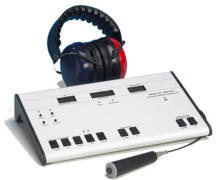Hearing Loss
How the ear processes sound by MED-EL
Audiologist Dr. Cliff Olson describes three types of hearing loss
How the Ear Works
Ears are a complex structures, constantly working to translate sound waves into electrical impulses to send to your brain. To give you an understanding of how the ear works, the video below describes how sound is processed in each part of the ear, the Outer Ear, the Middle Ear, the Inner Ear and the Auditory Pathway.Types of Hearing Loss
Depending on the site of lesion there are primarily 2 types of hearing loss. Conductive: Originating from the outer and the middle part of the ear. Sensorineural- Originating from the Cochlea and the Nerves.- Hearing loss due to ageing , exposure to -toxic agents and long term exposure to loud noise is generally sensorineural in nature. 6 out 10 Australians above the age of 65 experience some age related hearing loss. As we grow old the ageing factor adds to the noise induced hearing loss and in some people it results in a quite precipitous decline in hearing. People with hearing loss due to the above two factors have very Tricky! hearing. Wives call them with selective hearing! Sometimes they can hear the same conversation word/s quite plainly, other times they miss it. It is because they loose the clarity under less than ideal listening conditions, this is due to a disproportional hearing loss at high frequencies. It is important to: Get your hearing tested to get a baseline of your hearing to monitor into the future. Do I need hearing aids??!!!- Well the answer is not necessarily! It depends on a combination of these factors- your living situation, your hearing loss and your hearing needs/ life style. Some people can get by using good communication strategies, however it needs participation from both speaker and the listener. Book with us for honest advice on your particular needs. Here is a short video on three types of hearing loss:Hearing Protection
To prevent damage to your hearing: • at clubs, live music and other loud events, wear earplugs, take frequent breaks and give your hearing 18 hours to recover afterwards. • wear earplugs or ear protection equipment, such as earmuffs, in noisy workplaces. • if you use headphones or earphones, limit use to an hour at a time then take a break. • don't listen to music at more than 60% of the maximum volume if you can use headphones and ear plugs to block outside noise. There are a range of hearing protection devices from custom fitted ear plugs to full ear cover earmuffs. For working environments, Health & Safety regulations govern the use of ear protection in noisy environments. At Hear Well Audiology, we can supply and fit a range of ear protection. Call us today to book an appointment and discover why we say at Hear Well Audiology, the difference is clear!
Tinnitus: Ringing in the brain by Josef Rauschecker (TED Talk)
Tinnitus
Tinnitus may occur when there is a problem with the auditory (or hearing) system, which is made up of the ears and parts of the brain. It is more common in people who have some hearing loss or other ear problem, but it can also occur in people who have normal hearing. Both adults and children can experience tinnitus. Older adults are more likely to experience tinnitus because of age-related hearing loss. Some of the more common causes of tinnitus include: • hearing loss • ear wax • exposure to loud noises • ear infections • tumours • head injuries • Ménière’s disease • some medicines Sometimes, however, it’s not clear why people develop tinnitus. In this talk Josef Rauschecker illuminates the science behind tinnitus as well as the current state of treatment options.
You can also find a range of video explanations for Tinnitus on the Tinnitus Australia YouTube Channel
•
Tinnitus: An Introduction
•
Understanding Tinnitus
•
Tinnitus: Treatment & Management
•
Tinnitus: Causes and Risk Factors
At Hear Well Audiology, we offer Tinnitus Assessments and counselling services to help you with the condition.
Contact us today to book an appointment.




Hearing Loss
How the ear processes sound by MED-EL
Audiologist Dr. Cliff Olson describes three types of hearing loss
How the Ear Works
Ears are a complex structures, constantly working to translate sound waves into electrical impulses to send to your brain. To give you an understanding of how the ear works, the video below describes how sound is processed in each part of the ear, the Outer Ear, the Middle Ear, the Inner Ear and the Auditory Pathway.Types of Hearing Loss
Depending on the site of lesion there are primarily 2 types of hearing loss. Conductive: Originating from the outer and the middle part of the ear. Sensorineural- Originating from the Cochlea and the Nerves.- Hearing loss due to ageing , exposure to -toxic agents and long term exposure to loud noise is generally sensorineural in nature. 6 out 10 Australians above the age of 65 experience some age related hearing loss. As we grow old the ageing factor adds to the noise induced hearing loss and in some people it results in a quite precipitous decline in hearing. People with hearing loss due to the above two factors have very Tricky! hearing. Wives call them with selective hearing! Sometimes they can hear the same conversation word/s quite plainly, other times they miss it. It is because they loose the clarity under less than ideal listening conditions, this is due to a disproportional hearing loss at high frequencies. It is important to: Get your hearing tested to get a baseline of your hearing to monitor into the future. Do I need hearing aids??!!!- Well the answer is not necessarily! It depends on a combination of these factors- your living situation, your hearing loss and your hearing needs/ life style. Some people can get by using good communication strategies, however it needs participation from both speaker and the listener. Book with us for honest advice on your particular needs. Here is a short video on three types of hearing loss:Hearing Protection
To prevent damage to your hearing: • at clubs, live music and other loud events, wear earplugs, take frequent breaks and give your hearing 18 hours to recover afterwards. • wear earplugs or ear protection equipment, such as earmuffs, in noisy workplaces. • if you use headphones or earphones, limit use to an hour at a time then take a break. • don't listen to music at more than 60% of the maximum volume if you can use headphones and ear plugs to block outside noise. There are a range of hearing protection devices from custom fitted ear plugs to full ear cover earmuffs. For working environments, Health & Safety regulations govern the use of ear protection in noisy environments. At Hear Well Audiology, we can supply and fit a range of ear protection. Call us today to book an appointment and discover why we say at Hear Well Audiology, the difference is clear!
Tinnitus: Ringing in the brain by Josef Rauschecker (TED Talk)
Tinnitus
Tinnitus may occur when there is a problem with the auditory (or hearing) system, which is made up of the ears and parts of the brain. It is more common in people who have some hearing loss or other ear problem, but it can also occur in people who have normal hearing. Both adults and children can experience tinnitus. Older adults are more likely to experience tinnitus because of age-related hearing loss. Some of the more common causes of tinnitus include: • hearing loss • ear wax • exposure to loud noises • ear infections • tumours • head injuries • Ménière’s disease • some medicines Sometimes, however, it’s not clear why people develop tinnitus. In this talk Josef Rauschecker illuminates the science behind tinnitus as well as the current state of treatment options.
You can also find a range of video explanations for
Tinnitus on the Tinnitus Australia YouTube Channel
•
Tinnitus: An Introduction
•
Understanding Tinnitus
•
Tinnitus: Treatment & Management
•
Tinnitus: Causes and Risk Factors
At Hear Well Audiology, we offer Tinnitus Assessments
and counselling services to help you with the condition.
Contact us today to book an appointment.

































